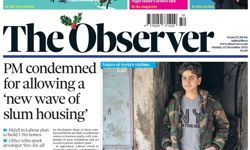Anyone who has ever been in charge of an annual newspaper promotional budget will tell you that, on one level, it is an enjoyable, varied and exhilarating role. But on the other, it’s a reactive, thankless task where you are seen to be only as good as your next promotion.
As newspapers are generally run by individuals (be it the proprietor, the editor or the managing director) and they work to tight deadlines, it is also a volatile environment in which to make clear decisions. Add to this the issue of monthly ABCs for newspapers (something I personally disagree with) and you have a very big task ahead.
The current economic climate means that every newspaper will have to reassess its promotional spend and either cut costs and be more efficient or carry out fewer promotions.
Categories of newspaper promotion
Over the last few years, with regards to promotions, newspapers have fallen into three categories: those that cover-mount consistently – The Daily Mail / Mail on Sunday, the Telegraph / Sunday Telegraph, the Independent / IOS and the Guardian / Observer; those who cover-mount sparingly – the Express / Sunday Express and Mirror / Sunday Mirror / People; and those who go through phases – the Times / Sunday Times and the Sun / News of the World.
Promotions also fall into three main categories:
* Added-Value (CD/DVDs and print-based promotions such as maps, posters, booklets, books, fold-outs)
* In-Paper offers (money off, 2-for-1, and other discounts)
* Retail (for example, a free bottle of water or £1 off a magazine when you buy a newspaper at travel outlets - helping achieve an easy purchase-switching decision)
In the past, most promotions were one-offs or weekend promotions; now there are longer promotions, with many stretching over 7 or 14 days for collectable series. It’s not uncommon for most papers to have some form of promotion prominently displayed on every day of the week.
Key elements of successful promotions
So what are the key aspects of good promotions?
Content is important, but without being overly controversial (as there is a vast amount of good quality content available), it should not be acquired at any cost nor should it be relied upon to deliver uplifts alone. It is the packaging of content, along with the way it is sold, that has the greatest bearing on the vast majority of promotions.
How things are sold is very important. I have seen some very good promotions undersold because people just didn’t ‘get it’. Some of the most successful promotions I have been involved with have had simple selling angles - Learn to Speak Spanish in 6 Weeks, Train your Brain in 7 Days, The No Diet Diet. Most of these were crafted with the editor and art editor with no more than six to eight words and sold heavily on the front of the paper.
Design is a much overlooked area. How a promotion looks (especially a collectable) is important. A one-off promotion should be bold, reflecting the subject matter succinctly. A collection should leave you wanting to complete the series, and where there are different formats (CDs, posters, and books), they should be designed so that they clearly come from the same family, even if the content is diverse.
Production values are key - how an item is produced is normally left to a production department whose main aim is to get products produced in the cheapest possible way (especially with high volumes). I would encourage promotions and marketing staff to visit print sites, manufacturing plants and finishing houses and find out what is possible; paper sizes, paper quality, finishes and costs. In my experience, if you want something out of the ordinary, if you ask a production manager, they will suggest it can’t be done, when you ask a printer / manufacturer they will tell you how much it will cost.
There are plenty of examples where good design has helped achieve good uplifts or good retention: the retro music CDs in the Independent that looked like vinyl records (complete with grooves) or the Guardian booklets on elegant matt off-white paper.
Promotion, advertising and marketing is another key area. It is also the area that’s changing the most. The times when newspapers could rely on a big media campaign as the only form of promotion are going to be replaced. Digital marketing, point-of-sale, sampling and all forms of joint marketing are now required to maintain uplifts, especially with the erosion of both base sales and frequency of purchase. My view is that marketing is going to be like hand-to-hand combat – promotions staff will have to hustle and target the specific audience that may be interested in the particular promotion. Normally, this will mean an imaginative and creative approach to negotiation.
Getting it right at the point of sale is another vital area. Merchandising, active selling, POS, sampling, static leafleting and retail specific promotions are possible and necessary to make a promotion stand out. Point of sale material is one area that publishers often get wrong. POS material must be simple and easy to read from a distance. Too much POS material is complicated, over-worded, or the wrong size. In my mind, if you can read a poster from the other side of the road, then it’s got a chance of influencing people to purchase. But, at the very least, the marketing / circulation staff who are responsible for producing POS material should go out with the merchandisers regularly to make sure that what they are producing is appropriate.
Subscriptions / Home Delivery
A new area to some (apart from the Daily Telegraph and the Times) is newstrade subscriptions whereby a reader can purchase, at a discount, a set of vouchers for a set period of weeks to be redeemed at newsagents. The Independent have introduced a guaranteed direct to door delivery scheme (which was closely followed by the Times) and the Daily Mail have heavily promoted the acquisition of seven day home news delivery customers.
What this shows is that publishers are concentrating on locking in their readers in the face of an increasing fickle readership. I would predict that the acquisition of subscriptions and home delivery will increase in the future.
Regional campaigns
Reduction in budgets, coupled with the pressures on circulation, has lead many newspaper publishers to target promotions to regions, retail groups or a discreet area of their readership (eg students). Cover-mounts, price tests, regional and link-saves advertising have all been used extensively and this trend is likely to continue. Regional campaigns are also useful to test new and different promotions and advertising campaigns before committing to an expensive national campaign.
Interpreting data and buying habits
There is still a great need to educate promotions / marketing staff (and quite a lot of circulation staff) about how to interpret data. The understanding of what works well, what doesn’t and how much it has cost is fundamental to promotional effectiveness. No sooner is one promotion finished than a new one is begun, so it is important that time is taken to review activities objectively and take a view if there are any implications for the future. In my experience, people have favourite projects that they champion at the expense of logic and objectivity.
All promotions and marketing (and circulation) staff should be asked to visit newsagents, supermarkets, petrol stations and convenience stores regularly. Unfortunately, many head office staff do not see the benefit of this, but how can you sell to readers if you don’t know how they buy? Whenever I’ve been stuck for ideas or in need of some inspiration, I visit a big newsagent or a supermarket and spend time scanning the magazines, newspapers (and other products). When I was at IPC we would show editors, publishers and designers their magazine positioned in crowded newsstands, otherwise they would only ever see the front cover on a very neat magazine stand in their own office.
The Future
I expect most newspapers will have reduced their marketing budgets for 2009 – the pressure on costs will be intense and every penny will have to be spent wisely. Those companies who carefully monitor spend, utilise partnerships, constantly analyse and review, and work hard at retail will thrive. It’s likely that the emphasis will be on retention of current customers rather than acquisition of new ones. Partnership marketing will replace pure content purchase, as utilising partner brands and their customers will reduce marketing costs. There will be increased activity at the point of purchase as each newspaper will attempt to influence purchasing decisions.
FEATURE
Promotional trends
Regular, eye-catching promotions have become a feature for many newspapers as they look to lock in existing readers and tempt new ones. David Greene looks at some promotional dos and don’ts and also at what the future holds.










